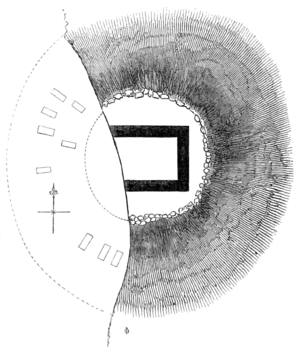the battle, to prevent their breaking their ranks, an expedient to which allusion is made in the Triads[1].
The spot which has been described, on the western shore of Holyhead Island, may, very probably, have been the scene of this cruel contest. The Irish were routed near Aberfraw, about ten miles distant; they fled towards their boats, and made their last stand on the narrow isthmus, defended by the sea on either side, with a plain adjoining, upon which their force might be drawn up. Here Caswallon must have sought to pass in crossing from Mona to Holyhead Island by the line of the old road. The Irish made stout defence to save their vessels, but they were defeated, Cerigi their chieftain was slain, and, possibly, the corpses were interred indiscriminately, forming the accumulation of remains found in the centre of the mound under the chapel. The single interments, in rudely formed cists around the tumulus, may have been those of chiefs who fell on this occasion. Again, the supposition is admissible, that these were the remains of the islanders massacred by the Irish, previously to their repulse by Caswallon. Cerigi, who fell in the fight, was regarded as a saint by the Irish, and his shrine was even long-time venerated in a chapel within the churchyard of Holyhead, called Eglws y Bedd (church of the grave), or by the British, Capel Llan y Gwyddel. The ruins were removed not many years since. It may reasonably be surmised that the spot where the bones of his victims reposed would be viewed with no common veneration, and might become the habitual burial place of successive generations of their kindred or descendants.
- ↑ See Rowland's Mona Antiqua.

